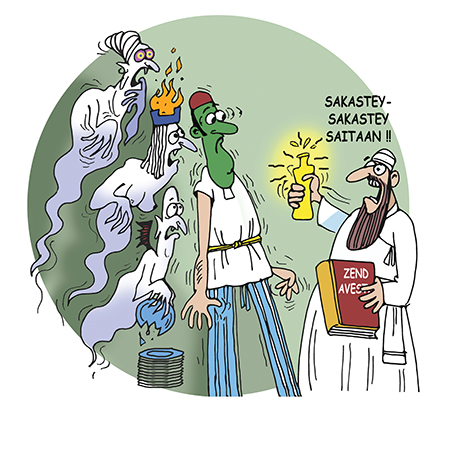Don’t look back
Berjis Desai
Superstition is nature’s way of preparing one for bad news. A curse is merely a public declaration of a preordained coming mishap which nevertheless makes the inflictor of the curse feel avenged that justice has been done. The residents of Navsari had great faith in both superstition and curses.
Woe betide the child who was born during a lunar eclipse! Hadn’t they all seen Dina whose face resembled an owl, a result of her mother, when urged by the midwife to push harder on the night of a lunar eclipse, spotting an owl perched on the window sill? And then there was this slightly shrewish lady who cheated a widowed fisherwoman of a few boi (mullet). The latter cursed her: "Cheating a widow, eh? Soon your daughter will be one.” And within a fortnight the woman’s 25-year-old son-in-law, a fully ordained and much loved priest, succumbed to typhoid.
Of course, not all curses succeeded so spectacularly. Pestonji bore concerted animus against Rustomji and announced to a stunned moholla that he would not touch meat until he first ate his bête noir’s chaarum nu botoo (for the uninitiated, the practice of eating meat on the fourth day after death, following three days of suffocating abstinence). Pestonji died a reluctant vegetarian. And mothers who placed a ball of rock salt and jaggery on the tongues of their duffer children entering an exam hall, as an auspicious rite, were nevertheless disappointed when Soli remained in the sixth standard for six years and Pervin matriculated after her ninth attempt.

Illustration by Farzana Cooper
Children were warned never to step on the remnants of broken eggs which had been circled around someone’s head lest the misfortunes of that blessed head entered the hapless stepper through his foot. Dosu was always bloody serious about avoiding such eggshells at a wedding after the aachhoo michhoo; and while he usually avoided the shells deftly, he once slipped on the white of the egg as he was about to present his pehraamni nu parikoo (cash gift) to the bridegroom. His head touched the bridegroom’s polished new shoes, and in the resultant embarrassment and confusion, he ended up giving his white handkerchief to the puzzled newlywed instead of the envelope.
Navsari Parsis were in great awe of the ubiquitous well in their paachloon baar (backyard). Never draw water after sunset unless to bathe a corpse and do sachkar (post death ritual ablution). Always have a large turtle floating in the well. Place a tiny lit ghee lamp in the niche of the well. Be alert if you see heaps of ashes around the well when you wake up in the morning — a sign of black magic being practiced. Never harm a snake or a cobra. Many shared the well with their immediate neighbors who drew water through an aperture in the wall.
Jaundice was cured by intoning Avestan mantras while gently running a needle on the hand of the afflicted, dipped in water that would soon turn yellow. A german silver thali containing seven pebbles, water, flowers and rice was passed over the body of a sunstroke victim who recovered almost instantaneously. Pious priests cured the very ill by clutching the right thumb and intoning the potent nirang or capsule prayer of the great Healer-Emperor Shah Faridoon; and by reciting the Ardibehest Yasht.
Girls were forbidden to step out on the night of Kali Chaudas before Diwali, as Navsari apprehended a climax in the activities of the practitioners of the sinister arts. Lal Vaid, the red costumed Ayurvedic doctor, prayed on that night at the Hindu burning pyres, to propitiate cure bestowing entities from the netherworlds. There were Parsis who gratuitously cured scorpion bite, and those who were amateur exorcists using the golden liquid (urine from bulls and cows did not putrefy for 72 hours; becoming potent when consecrated through the nirangdin ceremony lasting 18 days) to drive out poltergeist. Folklore had it that djinns were very tall and had multicolored eyes; bhoots were rather compact and broke things; daakans carried coal fired stoves or sagris on their heads. Of course, they were all unfortunate juddins (though Bhoot was Parsi surname — Kaikhushru Bhoot being a famed Parsi caterer of the ’60s).
It paid to be hospitable to visiting sadhus. Navsari knew of a lady whose knuckles swelled and began to emit dozens of needles from the fingers because she had refused to give water to a thirsty sadhu as she was absorbed in stitching with a needle. And eye contact was to be avoided with a certain beggar lady who arrived on Mondays at dusk when the dim lights lengthened the shadows and she gave out a yelping cry. A solitary vulture perched on the tiled roof of a house meant it was time to contact the life insurance agent ["Muncherjee na ghér pur geedh ék kalak thi bèthooch (For the past one hour a vulture has been sitting on Muncherjee’s house)”].
And there were many legends around the Towers of Silence. Once the geh sarna was performed, there was no going back, quite literally. About 90 years ago, an old lady revived miraculously after being placed in the dakhma. The startled nassesalars hit her on the head with the handle of the bier. Once memory had been wiped out by the prayers, perhaps the hard disk had to be destroyed.
Lastly, when this columnist was a boy of 10, he asked his aunts who the old man smiling at him from the second floor window of the house across the moholla was. The startled adults looked at each other and told him not to imagine things. The gentleman had apparently lost his wife and two young children in the Quetta earthquake in 1935 and had committed suicide a year later, jumping from the same window from which he had smiled at us.
Berjis Desai, author of Oh! Those Parsis and The Bawaji, occasionally practices law.
